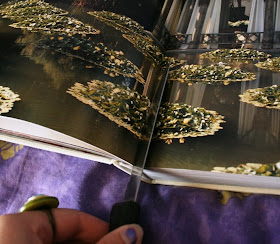This may not seem like the most useful skill right now, but just wait until I put up all the different things you can make with these pages - you won't want to lose a centimeter of the paper to ripping!
Ok, so first step... You Will Need:

A book you no longer want to read
and
A knife. A craft knife is probably best but a kitchen knife will work too... just any knife that's handy.
You can use any type of book, because of course thin paper book pages are useful for decoupage and other crafts, but in this tutorial and others I will be using a book with large, thick, shiny pages... a coffee-table book, essentially.
Ok. If you want to know how to take apart a book, you need to know how it's put together.
If you look at any book that's actually bound, and not just stapled together, and look closely at the paper where it meets the spine, you will see little groups of pages folded in half.
When a book is bound, a certain amount of pages are stacked, sewn down the middle, and folded in half. Then these packets are glued into the spine.

In this picture, the pages on the left have had the insides of the packets removed, leaving only the outer page of the packets, which is glued to the spine.
So step one is to find the packets in your book!
Once you do find a packet, find the inside pages of the packet - the ones not glued to the spine.

Open the book to the front or back of this inner packet, so that one of the pages you're looking at is the one glued to the spine, and one of them is the front or back page of the inner packet.

Taking your knife, run it along the crease where the pages meet.

This will cut the threads that hold the inner packet to the outer pages. It may help if you grip the inner packet and pull with one hand and use the knife with the other. I'd show this in my pictures but I'm using the other hand to hold the camera, lol.


Soon you should be able to pull the inner packet away. Open the inner packet.

The pages in the packet should come apart very easily, as the threads holding them together have already been cut.

Et voila! Beautiful, unripped pages twice as big as if you'd ripped them out!
Coming up next... what the heck to do with them!



























